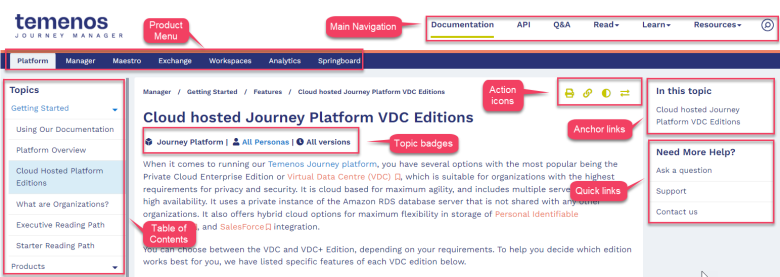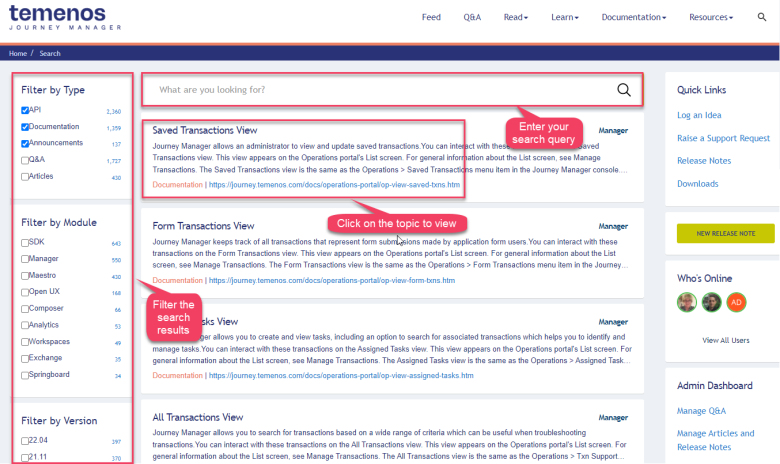Welcome to the Temenos Journey Manager documentation!
PlatformApplicable to all products in Temenos Journey Manager. | All Personas | All versions This feature is related to all versions.
Here are some tips on how to quickly and easily find the wealth of product information available on Temenos Journey Manager.

Each topic has been written in an intuitive way, and where possible, version agnostic, with an individual Table of Contents per product and a consolidated website-wide search function. Here are a few key concepts and navigation options for getting the best out of our offerings:
- Main Navigation
- Product Menu
- Table of Contents
- Action icons
- Anchor links
- Quick links
- Search
- API technical docs
- Topics
- Versions
- Badges
- Feedback
- What's Next
Let's look at each of these options in more detail.
Main Navigation
The Main Navigation allows you to explore the Temenos Journey Manager resources website and provides the following categories to make your journey easier:
- Documentation includes detailed information for all Journey Manager products.
- API contains the technical documentation.
- Q&A allows you to ask questions of the user community.
- Read displays the product announcements and blogs.
- Learn contains online learning videos for all products.
- Resources presents the video library, product downloads, Exchange packages (with a region filter) and all product release notes.
- Contact points you to the Knowledge team with any question or feedback you might have.
Product Menu
Use the Product Menu to select the Temenos Journey Manager (TJM) product you wish to explore. You will be presented with an individual Table of Contents for the documentation you are interested in.
Table of Contents
Each Table of Contents contains the topics related to the product you selected from the Product Menu. Use Platform to read the higher level platform topics that relate to the Temenos Journey Manager platform.
Action icons

Use the Action buttons to - Print the page, Copy the URL of the page to send to others, toggle between Dark/Light Mode, or Expand/Collapse the right hand side panel.
Anchor links
Click on the anchor links in the In this Topic panel to jump to a specific section of the topic.
Quick links
Use the quick links to Ask a question on the Q&A forum, go to the Support section, or Contact the TJM Knowledge Team.
Search

Searching our documentation is the fastest and most flexible way to find what you need. The Search is always available on the Main Navigation and ready to go!
Click the Search icon to display the website-wide search page. Start typing what you're looking for in the search panel. As you type, the search engine looks through all our content on the website and lists everything that matches your query.

You will also notice that each search match displays a topic title, a paragraph where the search keyword or phrase is found, the type of documentation or article found (documentation, API, article, Q&A, announcement) and the URL of the topic.
Currently, Fluent API and Core Transact API auto-generated documentation is not included in the search engine, so you need to navigate to a specific version of API documentation and use its Javadoc search functionality to search for your query. For more information, see API technical docs.
Often the search query returns many pages of results, so scroll through the pages using the pagination at the bottom of the screen to find your exact match.
Simply click on the link of the topic or article you want to read.
Filter options
To narrow down the search results, you can filter using content type, version or product.
Google Search
You can also search our documentation using Google! Regularly Google index the website, so simply run a query from your browser, such as site:journey.temenos.com/docs/ "what you are looking for".
API technical docs
If you are looking for technical or developer documentation, use the API section of the website.
Topics
We use individual topicsTopic-based authoring is a modular approach to content creation where content is structured around topics that can be mixed and reused in different contexts. to author and organize our documentation. Each topic is a self-contained article describing a particular concept or a procedure that can stand on its own, give enough information to the reader, and provide links to another related topic to create a learning path. Topics are designed to minimize repetition, provide a reader with easily digestible piece of information and ensure there's a single source of truth for every concept and feature.
Topics are not meant to be long; on the contrary, they are deliberately written short to answer only one particular question or explain a specific action, for example, how to create a service. Let's look at this topic to explain how to use our documentation to your maximum benefit.
The first paragraph of the topic (as well as any other topic) explains what you can achieve by reading it and why you need it. You always find one or two links in the introductory sentence, so you can learn more about the concept described in the topic. In this example, they are a link to the Journey Manager Overview topic and the Services Overview topic. This is your learning path, the pre-requisites you must learn to understand the Create a Service topic. Where relevant and important, we add links, so you must read these topics too to understand what other steps you must perform, in this example, to create a service. Each topic ends with a paragraph describing what you should read next and a link to that topic. The paragraph starts with Next keyword. This is your learning path.
A complex content usually requires several or sometimes a dozen of topics to explain it. However, don't be alarmed that you need to click a dozen links to read it all - if you are lost at some point, you can always find where you are in your learning path by exploring the Table of Content.
Versions
Each topic is given a version 'badge' to indicate what version is applicable to the topic, such as when the topic is newly created, updated, or deprecated.
We have written the documentation in such a way as to make it version agnostic, and describe the most recent version of the products, unless otherwise specified. This allows the number of versions for each topic to be minimized, and all users have access to the same content, regardless of the product version they use. When there is a product or feature difference between versions, it is noted inline, for example, | 22.10 This feature was deprecated in 22.10.
Version badges let you get more information from our documentation, such as when a feature was created and when its parameters were added. For example, looking at the Database Integrity Checker Service article, you can easily see that this service was introduced in | 23.04 This feature was introduced in 23.04 whilst the Delete Orphaned Records option was added in | 24.10 This feature was introduced in 24.10. This means that clients on Journey Manager prior to 24.10 don't have the Delete Orphaned Records option available, so if they need this functionality, they should consider upgrading to 24.10.

If you are looking for information like this, you can search our documentation using 2 keywords - Database Integrity Checker Service and Delete Orphaned Records - and then check the release notes - What's new in 23.04 and What's new in 24.10 respectfully. There you will find the same information with some additional details.
Badges
Every topic also includes Product and Persona badges, as well as the Version badges mentioned above:
- Product - to identify the product, or products, the topic relates to.
- Persona - to help identify the reading audience and create a learning path. For more information, see understanding personas.
- Product version - that the topic is compatible to, and indicates whether the whole topic, or a feature, was created, updated or removed.
Feedback
Use Contact from the Main Navigation, or Contact us in the quick links, to contact the Knowledge team with any question or feedback you might have.
What's Next
Learn about the customer onboarding journeys you can create with Temenos Journey Manager. Read the Platform overview to get started!